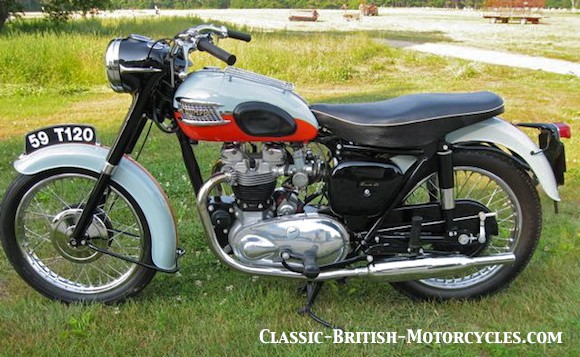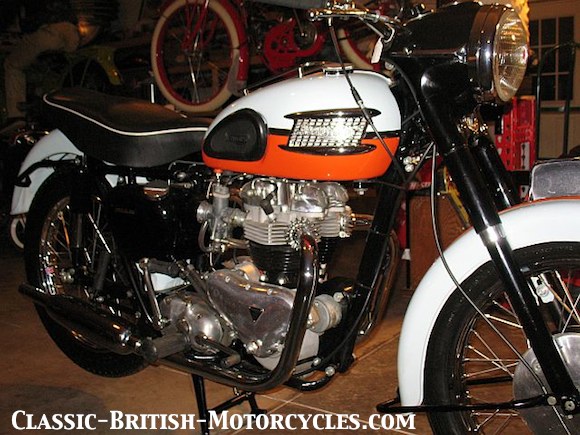ABOVE: The 1959 Triumph Bonneville had the big fenders and nacelle of the Triumph Thunderbird. Not a popular move with Americans, many of whom swapped it out for the more svelte TR6 bodywork.
ALL NEW BIKE
When it was introduced, the 1959 Triumph Bonneville 650 was one of, if not THE fastest motorcycles you could buy. It was a real hot rod! The new T120 designation is supposed to suggest that it could do 120 mph! Actual road tests done by motorcycle magazines of the day topped-out a box-stock ’59 Bonnie at 108 mph. Not quite 120, but very fast for 1959! This was the only year with no letter designation after the T120.
LOOK NOT QUITE RIGHT
Production of the new T120 began at Triumph Motorcycles Meridan plant on September 4, 1958 with Engine #020377. All 1959 Bonnevilles came in Pearl Grey and Tangerine, a color combo that didn’t play well in America. Another thing the Yanks didn’t like was the ‘bodywork’. Triumph had styled the new 1959 Triumph Bonneville more closely to the Thunderbird, with a headlight nacelle and full fenders. It was better suited to rainy England where good weather protection and ease of cleaning were important. What America wanted was a stripped-down street racer like the TR6. By 1960, Triumph addressed ABOVE: 1959 Triumph Bonneville – Big fenders & nacelle of the Triumph Thunderbird.
ALL NEW BIKE
When it was introduced, the 1959 Triumph Bonneville 650 was one of, if not THE fastest motorcycles you could buy. It was a real hot rod! The new T120 designation is supposed to suggest that it could do 120 mph! Actual road tests done by motorcycle magazines of the day topped-out a box-stock ’59 Bonnie at 108 mph. Not quite 120, but very fast for 1959! This was the only year with no letter designation after the T120.
LOOK NOT QUITE RIGHT
Production of the new T120 began at Triumph Motorcycles Meridan plant on September 4, 1958 with Engine #020377. All 1959 Bonnevilles came in Pearl Grey and Tangerine, a color combo that didn’t play well in America. Another thing the Yanks didn’t like was the ‘bodywork’. Triumph had styled the new 1959 Triumph Bonneville more closely to the Thunderbird, with a headlight nacelle and full fenders. It was better suited to rainy England where good weather protection and ease of cleaning were important. What America wanted was a stripped-down street racer like the TR6. By 1960, Triumph addressed this.

HOT ROD BONNEVILLE
How do you build a hot rod? They stared with a T110 engine (already fast), added a high-lift E3134 inlet cam and a E3325 exhaust cam, bigger valves (1-1/2″ inlet, 1-1/32″ exhaust) porting and polishing, higher compression (8.5:1), stronger pistons, a strengthened, one-piece forged crankshaft (EN16B) with bigger 1-5/8″ journals and ball bearings at both ends. Fitment of a new 2-1/4″ wide flywheel dropped the balance factor from 70% to 50%. Crankshaft balance factors would rise and fall over the years, in an effort to combat vibration. The vertical twin had started out with 500cc and 26 hp, and vibration wasn’t much of an issue. But now, it was up to 650cc and pumping out 46 hp at 6500 rpm. Vibration was starting to reel its ugly head and as the quest for more and more power continued, it only got worse. Heavier cranks, lighter cranks, different bearings, balance factors all the way up to 81% came and went, but the vibration never left.
BIG CARBS
This new fire-breathing engine was fed by two 1-1/16″ Amal Monobloc carburetors that shared a common, remote float bowl (Amal 14/617) that was mounted to the frame. This proved unsatisfactory as many owners experienced fuel starvation and stalling under heaving braking. This was soon remedied with the adoption of ‘normal’ Amal Monobloc carburetors each with their own integral float bowl. The float bowl screws were safety-wired (forming a triangle of wire) to keep them from loosening under vibration. The ‘tickler’ valve was on the remote float bowl. There were no air filters, just little polished aluminum bellmouths. Main jet size was 240, pilot jet 25 and needle jet 0.1065.
TRANSMISSION
The rest of the 1959 Triumph Bonneville was pure Tiger T110. The 4-speed gearbox, which traced its ancestry back to the original one used in the seminal 1937 Speed Twin, was taken directly from the T110. Inside the primary case, the engine sprocket had 24 teeth and the clutch sprocket 43, with a 70-link endless 1/2″ X 5/16″ single-row chain, tensioned by pivoting the transmission in its mounts. Final drive was by 101-link 5/8″ X 3/8″ chain with a 18-tooth front sprocket and a 46-tooth rear wheel sprocket.
IMPROVED CLUTCH
The added power brought about by the twin carbs and all the other ‘hot rod mods’ (the Tiger made 40 hp to the 1959 Triumph Bonneville’s 46) proved to be more than the overtaxed clutch could handle. So, this too was upgraded with a new Neolangite friction surface on its 6 drive and 5 driven plates, and the clutch center was hardened.
FRAME
The 1959 Bonneville’s frame is identical to that of the 1959 Tiger T110. Introduced on the 1954 T110, the rear swing arm was poorly supported in the frame and tended to flex, earning it the nickname “Whip Iron”, due to its tendency to wobble and weave. This would be remedied in 1960 with the adoption of the new, and much-reviled ‘duplex frame’, which solved the swing arm issue, but brought with it a whole new set of problems.
RUNNING GEAR
The footpegs attached direction to the engine mounting plates, bewteen the engine and tranny, with the left one passing through the primary case (not good if you dropped it on that side, eh>). Rear shocks were fully-enclosed Girlings with 100 lb/ft spring tension and adjustable pre-set. The telescopic forks were straight off the 6T/T110 line. The bike sat on a 55-1/4″ wheelbase with a 64-1/2 degree steering head angle. The frame was made by sweating or brazing steel tubes into cast lugs, which was standard practice for the day. Welded frames came much later.
WHEELS & BRAKES
Also shared with the T110 were wheels and brakes. The front was an 8″ full-width single-leading-shoe (SLS) unit, laced with 40 identical 8/10G X 5-5/8″ cadmium-plated spokes to a 19″ chromed WM2-19 rim fitted with a 3.25 X 19 Dunlop ribbed tire. The standard rear wheel had a 7″ cast iron drum with SLS brake, laced (with 8/10G X 8″ spokes on the left, and 8/10G X 8-3/8″ on the right, all with right-angle nipples) to another WM2-19 (identical to the front) chromed rim steel rim with a 3.50 X 19 Dunlop Universal tire. There was also an optional Quickly Detachable (QD) rear wheel that allowed for fast and easy rear wheel removal with very few tools.

SEAT
There were two seats offered for the 1959 Triumph Bonneville, but its unsure when the changeover was made. The first ones came with the Tiger 110s dual seat, later ones with a slimmer ‘sports’ seat from the Trophy models. Both were covered in waterproof black “Vynide” with white piping. Some of the later versions also had gray trim around the bottom edge. California-bound bikes needed a safety strap, by law, so a kit was provided and installed by the dealer.
BODYWORK
But it was the sheet metal, the ‘bodywork’ that was most controversial. Most Americans were put off to the fully valanced fenders, since they do very little riding in the rain, and they just looked out of place on such a sporting bike. Almost all 1959 Triumph Bonneville were painted the same, but a few very late ’59 UK and export machines went out with Azure Blue replacing the Tangerine. The fenders were painted in Pearl Grey with a Tangerine (orange) stripe running down the center, following a longitudinal raised section. The two colors were separated by a lovely gold pin-stripe (hand striped by craftsmen). The 5 qt. oil tank was on the right side, with a matching battery and tool box on the left. Both were painted Pearl Gray, although some very early UK/Exports were black. The oil tank had a gold transfer about halfway up indicating proper oil level, and the tool box had a small gold “Bonneville 120” transfer on it. The all steel, welded tank held 4 Imperial-gallons in the UK and most export markets, but the US got a smaller 3-Imperial gallon unit. The top half was painted Pearl Gray and the bottom half Tangerine, separated in various places on the tank, by chrome trim, the knee pads, and gold striping. The Triumph tank badge is quite large and impressive. The famous ‘Grille Badge’ features the classic gold-accented Triumph logo over a forward-leaning chrome grille with 11 vertical stays and 7 horizontal ones, bracketed on top and bottom by streamlined, high-stylized chromed ‘eyebrows’. GORGEOUS! Triumph certainly knew how to build a pretty motorcycle!
Special thanks go out to MidAmerica Auctions for their generous permission to use the above images.
1959 Triumph Bonneville SPECIFICATIONS
|
Engine type Displacement Bore & Stroke Compression Carburetor Ignition Engine output Primary drive Primary sprockets Clutch Gearbox Ratios, overall: 1st, bottom 2nd 3rd 4th, top Final drive Final drive sprockets Frame Type Suspension, front Suspension, rear Brake, fron tBrake, rear Tire, front Tire, rear Wheelbase Seat Height Ground Clearance Fuel capacity Dry weight |
Air-cooled OHV vertical twin, non-unit 649cc / 40.0 ci 71mm X 82mm / 2.79″ X 3.23″ 8.5:1 2- Amal Monobloc 1-1/6″ Lucas magneto 46 bhp @ 6500 rpm 1/2″ X .335″ X 5/16″ chain, 70 links 24T X 43T Multi-plate, wet 4-speed constant mesh, right foot shift — 11.9:1 8.25:1 5.81:1 4.88:1 5/8″ X .400″ X 3/8″ chain, 101 links 18T X 46T Brazed lug, rigid Telescopic fork, hydraulic damping Swing arm, 2 Girling dampers 8″ SLS drum 7″ SLS drum 3.25″ X 19″ Dunlop 4.00″ X 18″ Dunlop 55.25″ / 140 cm 30.5″ / 77 cm 5″ / 12.7 cm 3 Imp gal (US); 4 Imp gal (UK & export) 404 lbs / 183 kg |


No Comment